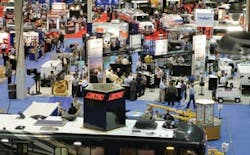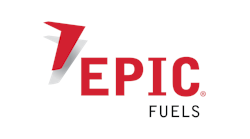The 2005 Aviation Industry Expo has come and gone, along with the GSExpo, AS3, NATA Convention and PAMA Symposium. The show proved to be an exceptional three days with nearly 450 exhibitors (on more than 109,000 net square feet of exhibit space - a six percent increase over last year) and the attendance kept pace with 2004's.
"We're very pleased with the outcome of this year's event," says Jill Hilgenberg, show director. "You could feel the energy and enthusiasm in the air as you walked through the show. Exhibitors were displaying their products and services in larger booths than in previous years, large sales were being made on the show floor and most of our GS seminars were standing room only. It was the best show we've had in years. Clearly, Aviation Industry Expo continues to be the place for the industry to meet."
The highlight for Ground Support Magazine was the first annual GS Leader of the Year award and luncheon. The winner is Jim Houck, system-wide manager for GSE, Continental Airlines. His varied and exceptional contributions to the GS industry can be found on page 32 along with a photo of him receiving the award. George Prill also shares his comments about Houck and the impact he has made.
The GS seminars were full of great information, and as Hilgenberg mentioned, were well attended. Here is a recap:
Tuesday
The week began with Running on Empty: Fuel Costs, Operations, Purchasing and Management where Walter Chartrand, Air BP Aviation Services, discussed the increase in air traffic and how that demand has increased the demand for fuel, raising the price. He also covered three anti-icing additive issues, proper storage and handling, correct ratio additive concentration and additive "fallout." James Gammon, Gammon Technical Products, picked up the pace with the prediction ADTUL will come on the market and discussion on the ATA-103 which will standardize fueling for the airline industry. He mentioned new vehicles need the API 1529 fifth edition, but third edition vessels are grandfathered in as well as a military program to inject additives to fuel at different points in order to eliminate fuel with unnecessary additions.
James Adams, 452nd Combat Sustainment Wing, presented Are the Needs of the Air Force Changing? The Future of Military Ground Support to a packed room. He mentioned the aging fleet of GSE as well as aircraft, GWOT and Army/Marine shortfalls, SE Decentralization and O&M Funding as future problems. He added that the AF is looking for lighter, more reliable, multi-purpose equipment; service life extension programs and urgency in phase procurement due to the current one year window for funds
Wednesday
At Outsourcing Trends: The Ground Handling Subcontracting Paradigm Shift we heard from Fraport Ground Services' Bernd Jungbluth and Rosa Beckett from the Airport Authority in Jacksonville, FL. They discussed the new Fraport Ground Handling services at JAX and from the AA's point of view, it will give airlines more economical options than they had previously. Brian Wood, ATS, said the trend for airlines is to want larger bid packages including multi-cities, from ground handlers. And those city packages are more encompassing and complex with new product lines such as passenger service functions. Wood sees airlines wanting "volume discounts" on services and airlines pushing airports for more GH choices, increasing competition. Jet Blue's Michael Graci pursues ground handling from a cost benefit analysis. If Jet Blue has many flights to an area, the GH will likely be done internally, but for cities with less than 5 flights a day, Graci gets quotes from the GH's and what it would cost to insource the services. Based on the quality and the price, they outsource or insource.
Goliath vs. Goliath: Airbus and Boeing See Different Futures began with an overview of Boeing's future 787 Dreamliner, planned for 2008, presented by Dharam Arora. The medium-sized, point-to-point aircraft will be compatible with existing GSE and airport infrastructure, include new technologies to reduce accidents on the ramp, be largely composite with advanced wing design as well as include a larger cargo capacity on passenger planes. Airbus followed with a dynamic presentation about the A380 from Tom Burger and Dr. Thilo Stilp. Burger focused on the benefits of the A380 including the increase in passengers without increasing the flights, comfort at lower costs and less noise. Stilp discussed the A380 and its minimal affect on ground operations as well as the number of pieces and types recommended.
Thursday
Moderated by the Airline Services Counsel's Stan Mackiewicz, AOA Safety and Security: Let's Stop Talking About It and Do Something! started with David Janney, DAL Global, who mentioned the basic principles to ensure safety and how DAL pro actively manages safety on the ramp, an example being its mentor program, near miss reporting and self-auditing. Walter Chartrand, discussed Air BP's initiatives, such as using interactive CDs, job analysis review, safety culture and root cause analysis. Lou Sorrentino, SH&E, explained the new SMS (safety management system) currently in the works. This will be a guidance document to assist a company in safety management, comprehensive incident and accident recording, goal setting, etc. The SMS manual will provide objective evidence so companies can prove their safety record.
GSExpo's final session "Lean, Mean and Green: Alternative Fuels in GSE Applications" provided a great deal of useful information from a variety of industry experts. Presented was an overview of the challenges (costs, infrastructure development, acceptance of new technologies) and the benefits (emission reductions, lower operating costs, ability to meet mandates) of alternative fuels and technologies. The panelists, Brad Compton of TUG, Carl Perazzola of Robbins Air Force Base, Jim Snyder of Big Clean Services, John Bradley of Automotivation, Rich Williams of Ford and Bill Elrick of The Torrington Group, discussed that one of the major obstacles to greater alternative fuel use was not limitation in technologies, rather a lack of industry awareness of the alternatives and the reluctance to change the status quo. The session also included an overview of the FAA's new Voluntary Airport Low Emission (VALE) program, recently established to provide funding assistance and emission reduction credits to support and promote alternative fuel use at airports across the nation. When the session did end, long after its original ending time, it was apparent that viable alternatives exist and that the industry is moving quickly in this direction.






